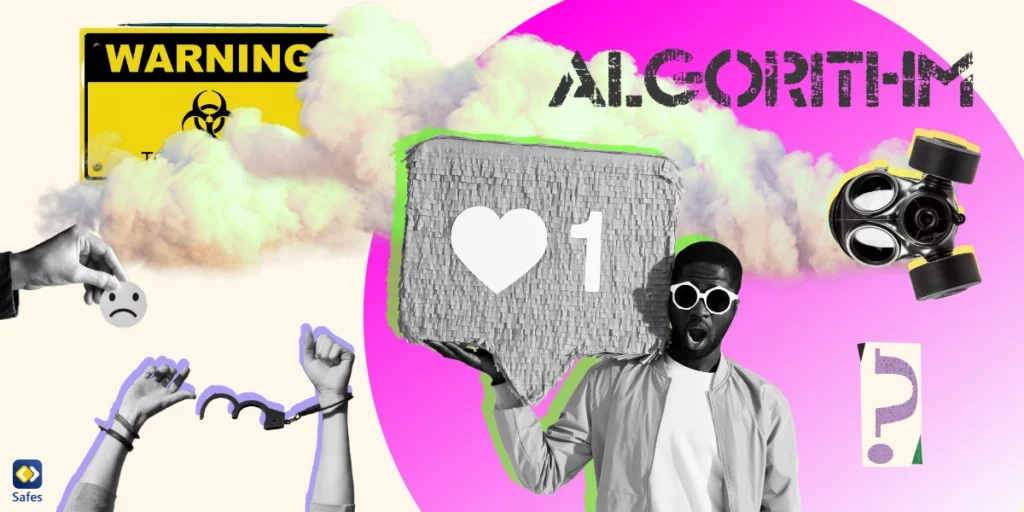Have you ever felt like you’re getting a never-ending chain of polarizing posts and bitter comments when you’re trying to relax while using your favorite social media platform? That’s no accident. That’s the invisible hand of social media algorithms at work, curating a digital reality that isn’t always sunshine and rainbows. In our blog today, we’ll pull back the curtain on how social media algorithms contribute to its toxicity, a phenomenon we’ll refer to as algorithmic toxicity. We’ll delve into how these algorithms shape our online experience and the ripple effects they have on our digital neighborhoods.
Download and Start Your Free Trial of the Safes Parental Control App
The Filter Bubble Effect: Echo Chambers and Divisive Ideologies
Social media algorithms are like your personal digital waiters, always ready to serve up what you like. But here’s the kicker, in their quest to keep you scrolling, they often end up spoon-feeding you more of the same. The result is what we call the filter bubble effect. It’s like you’re stuck in a hall of mirrors where all you see are reflections of your own views. And the casualty is diversity and open dialogue. It’s like having earplugs in at a world symphony, and that is how these algorithms are stirring up a storm of divisiveness in our digital neighborhood.
The Quest for Attention: Likes, Engagement, and Toxic Behaviors
There’s a bit of a buzz going around about whether “Is social media toxic?” is a valid question. And it all comes down to algorithms. They’re the real puppet masters here, pulling the strings behind the scenes. Their primary goal? To prioritize the content that rakes in the most engagement.
But here’s the catch, these algorithms often end up promoting what’s loud, shocking, or controversial, as these elements tend to generate more interactions. This scenario cultivates an environment for attention-seeking behaviors and outrage culture to flourish. It’s like throwing a rock into a pond and watching the ripples spread; the more disruptive the content, the wider the ripple effect.
In the long run, this amplification of harmful content can lead to significant knock-on effects. We’re talking about creating echo chambers that limit diverse perspectives, fostering divisiveness, and perpetuating an often toxic digital climate. So, when we ask, “Is social media toxic?” it’s not just about the platform but the algorithms that steer the platform.

Comparison of Culture and Social Media Envy
Algorithms are like those friends who only tell you what you want to hear. They curate content based on what they think will keep you scrolling—and nothing feeds the scroll monster quite like envy. This is where the influencer culture comes into play. When algorithms keep showing us the glamorous lives of others, it’s easy to feel like we’re not doing enough, not achieving enough, not being enough. And that can take a heavy toll on our mental health.
So, the next time you feel envious while scrolling through your social feed, remember: it’s not you; it’s the algorithm. It’s time we start having real conversations about the psychological impacts of this social media toxic culture because, let’s face it, no one’s life is as Instagram-perfect as it seems.
The Viral Spiral: Misinformation, Disinformation, and Algorithmic Amplification
Isn’t it wild how a harmless scroll on Instagram can turn into a toxic misinformation hotspot? Algorithms have a knack for pushing up content that gets our hearts racing and our fingers tapping. And that’s how, just like that, we might tumble down a rabbit hole of conspiracy theories and fake news. The algorithm doesn’t distinguish truth from fiction—if we engage, it delivers.
Cyberbullying and Hate Speech: Algorithms as Enablers
If we were to picture the darker side of social media for you, we’d have to acknowledge that algorithms can, unfortunately, become accomplices in cyberbullying and hate speech. Now, it’s not that they’re inherently evil, but their follow-the-engagement rule can lead to the spread of harmful content. The platforms? Well, they’re like the guardians of this digital playground. They have a big role in addressing these algorithmic biases and making sure everyone plays nice.
Addiction Machine: Psychological Vulnerabilities and Algorithmic Design
Social media algorithms learn our likes, dislikes, and in-between bits, serving up content that keeps our thumbs scrolling in a never-ending digital buffet. They exploit our need for validation, our fear of missing out, and our desire for connection, all to keep us hooked.
This algorithm-driven addiction can lead to anxiety, depression, and other health issues. It can skew our perception of reality, stir up feelings of inadequacy, and even disrupt our sleep. So, while social media can be a hoot, it’s crucial to remember it’s not always as sweet as it seems.
The Illusion of Authenticity: Perceptions of Reality and Algorithmic Influence
Algorithms are not just sorting out what you see on your feed—they’re subtly molding your perception of reality. That cute cat video? Algorithm. That political rant? Algorithm. The influencer with the perfect abs and the avocado toast? You guessed it—algorithm.
Curated content, alluring as it is, can be a double-edged sword. On the one hand, it makes us feel connected, keeping us in the loop of the latest trends and happenings. But on the flip side, it can distort our sense of authenticity, making us feel like we’re always a step behind the Joneses.
And let’s not forget the influencers, the social media royalty. They often present a filtered, airbrushed version of life that can warp our self-perception. Their flawless lives can make us question our own, causing us to feel inadequate, when in reality, they’re facing the same ups and downs as us—just off-screen.

Empowering Users: Taking Control of the Social Media Experience
Now you see algorithms aren’t just innocent bystanders—they’re active players in the game, shaping our experiences, perceptions, and even our identities. So, we’ve gathered some great tips and strategies that can help both you and your child take control of your social media experience.
First off, don’t let your feed become a monotonous echo chamber. Mix it up! Follow an array of folks—artists, scientists, chefs, philosophers—anyone who adds a different color to your digital tapestry.
Second up, remember that little cogwheel icon? That’s your privacy settings. It’s like the secret door to your social media sanctuary. Play around and tweak it until you feel you’ve got the right balance between sharing and personal space.
Lastly, let’s flex our critical thinking muscles. Be a savvy surfer in the sea of information. Question what you see, cross-check facts, and remember: influencers are folks just like you and me, with their own quirks and biases.
How Can Safes Help Your Kid Avoid the Harms of Social Media?
The Safes parental control app is a comprehensive tool that can do a lot to protect your child online. Safes offers the power to dial down those addictive hours spent online, and it’s a fabulous way to guide your child away from the not-so-nice corners of the internet. You can decide how much time your kid gets to spend on different apps, including social media. You can block any app that you find unsuitable for your child. Best of all, you get reports of your child’s activity on social media and messaging apps like Instagram, Facebook, YouTube, and WhatsApp. So, you can protect your child before they get into trouble.
With Safes, it’s all about promoting healthy digital habits and keeping the internet a safe playground for your youngsters. It’s available on all phones, tablets, and computers using Android, iOS, Windows, and Mac platforms. Learn more about putting parental controls using Safes with the links below:
- Windows parental controls
- Macbook parental controls
- Parental controls on Android
- iPhone parental controls
You can start safeguarding your child with a free trial today!
Towards Ethical Algorithms: Advocating Transparency and Accountability
Do you know what’s super important but doesn’t get enough attention? Transparency and accountability in social media algorithms. Sounds techy, but let’s break it down for you. Just like you’d want to know what goes into your food, you should know how these algorithms work. It’s all about being upfront and honest.
Companies behind social media and algorithms should be responsible for what they produce. We must tell these tech giants, “Hey, if your algorithm messes up, you’ve got to own it and fix it.” Responsible algorithmic design is a must-have. It’s not just about keeping users hooked; it’s about creating a healthy, diverse, and respectful digital space.
And let’s not forget user empowerment. You should be in the driver’s seat, not the algorithm. You should control what you see when you see it, and how you engage with it. It’s your social media experience, after all, not a magic show run by a hidden algorithm.
Conclusion: Why Social Media Is Toxic
The digital world can be full of excitement but also hazards. It’s a fact that social media can be a toxic playground, especially for the young ones. But hey, you’re not powerless. With tools like the Safes parental control app, you can keep an eye on your kid’s screen time and social media scrolling. It’s all about cultivating good digital habits and creating a safer, respectful online space. Remember, the key is to balance transparency, accountability, and user power.
Your Child’s Online Safety Starts Here
Every parent today needs a solution to manage screen time and keep their child safe online.
Without the right tools, digital risks and excessive screen time can impact children's well-being. Safes helps parents set healthy boundaries, monitor activity, and protect kids from online dangers—all with an easy-to-use app.
Take control of your child’s digital world. Learn more about Safes or download the app to start your free trial today!




